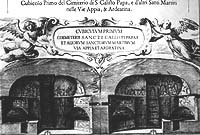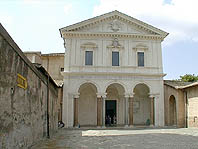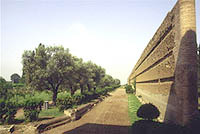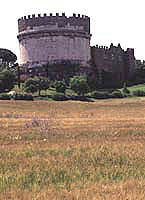Via Appia Antica and Catacombs
Tombs and Catacombs
 There are 69 catacombs in the outskirts of Rome and thousands of tombs. Under ancient Roman law no one could be buried inside the city, for sanitary reasons. All the Consular Roads were lined with the handsome tombs of patricians, most of whom were cremated and their ashes preserved in urns.
There are 69 catacombs in the outskirts of Rome and thousands of tombs. Under ancient Roman law no one could be buried inside the city, for sanitary reasons. All the Consular Roads were lined with the handsome tombs of patricians, most of whom were cremated and their ashes preserved in urns.
Because they had to be ready for resurrection, the Christian dead were buried, uncremated, in underground caves hollowed out of soft tufa stone.
It is now generally accepted that these "catacombs" were not where the early Christian community hid from persecution, but where they gathered to honor their dead, particularly martyrs and Popes - usually by staging banquets.
The word Catacomb, now used for any subterranean burial place, presumably comes from the Greek "hollow," which was the name of the area of stone quarries located around the San Sebastiano Catacombs.
Only five of the catacombs are open to the public. There were also six Jewish Catacombs, four of which have disappeared; the others, including one at Via Appia Antica 119A, are closed.
![]() At the intersection of Via Appia and Via Ardeatina, the short road from the gate to the tombs is a moment of bucolic.
At the intersection of Via Appia and Via Ardeatina, the short road from the gate to the tombs is a moment of bucolic.
Catacombs of St. Callisto
Here are over 12 miles/17 kms of underground galleries, arranged on four and sometimes five levels, reaching deep down into the earth. They are lined with hollowed-out niches ("loculi"), frequently two or three high, in which the dead were wrapped in double layers of cloth interspersed with lye to protect the living.
The Papal Crypt and the Crypt of St. Cecilia are of religious and historical interest. In the former repose at least five martyred and sanctified Popes who reigned between 230 and 283. Note the marble plaques with the Greek letters MTP for MarTyR. Elegant 4th C decorations were added by Pope Damasus I.
In 821 Pope Paschal I separated St. Cecilia's corpse from that of her husband St. Valerian, and had her re-interred in her own house, now part of the Church of St. Cecilia in Trastevere.
Cecilia-veneration is based on her legendary life and death. Having converted her husband to Christianity and persuaded him to live in chastity, they were guarded by an angel until Emperor Diocletian's persecutions in 303. Valerian, refusing to sacrifice to idols, was martyred first. Cecilia, condemned to death by suffocation in her own bath house in Trastevere, survived for several days while singing hymns - thus making her the Patron Saint of Music. Ordered beheaded, she suffered three ineffectual ax blows, gaining several days during which she made a host of conversions before dying in agony.
In these subterranean tunnels watch for the 2-3C wall paintings in the Sacraments Crypt and Lucina's Precinct.
| Catacombs of St. Callisto The Amazing History of St. Callisto 1C. AD. Poor Roman families, pagan and Christian, formed cooperatives to bury their dead in these tufa stone quarries. 180-192. Emperor Commodus, soft on Christianity, gave in to his mistress Marcia, an enterprising Christian, and freed Church members condemned to hard labor in the mines. With them Calixtus (Callisto), a slave convicted for fraud and brawling in a synagogue, escaped. 199. Calixtus was installed by Pope Zephyrinus as a church deacon and keeper of this cemetery, the first to become legal property of the Christian Church. 217. Calixtus, always enterprising, became Pope. He died five years later and, on dubious evidence of martyrdom, became a Saint. This Christian cemetery was named after him, although he is not one of the several 3C Popes buried here. 366-384. Pope Damasus I got Emperor Theodosius I to make Christianity the State Religion and restored the catacombs, to prove that Rome's real glory was not pagan. |
Catacombs and Basilica of St. Sebastian
These were the first Christian tombs to be known as Catacombs, named after this valley. One of the seven pilgrimage churches of Rome, this one is named for St. Sebastian who is buried here.
The catacombs, four levels deep, are similar to those of San Callisto. There are fascinating early paintings, graffiti, stucco work and fine mosaics.
In the first chapel to the left in the Baroque church is a smooth white-marble St. Sebastian sculpture full of arrow holes after a design by Bernini but carried out by Antonio Giorgetti. The adjacent steps lead down to a crypt with the urn containing the Saint's relics.
Other Holy relics, visited by pilgrims for centuries, are in the right absidal chapel, including what are believed to be a stone with the footprints Jesus Christ left when he met St. Peter fleeing from Rome, arrows which pierced St. Sebastian and the column to which he was bound, as well as the hands of St. Callisto and St. Andrew.
The catacombs, four levels deep, are similar to those of St. Callisto. There are fascinating early paintings, graffiti, stucco work and fine mosaics.
| Catacombs and Basilica of St. Sebastian History 1C AD. Three mausoleums built for burying first pagan, then Christian dead. 258-298. Due to Emperor Valerian's persecutions, St. Peter's and St. Paul's corpses were kept here for 40 years. 288. St. Sebastian, a Roman officer, was condemned to death for preaching Christianity to the troops. He survived being riddled with arrows by an execution squad. While recovering he confronted Emperor Diocletian who had him beaten to death. 4C. Emperor Constantine, Defender of the Faith, built a basilica over the earlier tombs. 1609-12. Cardinal Scipio Borghese had Flaminio Ponzi construct the present church on top of the basilica. |
Via Appia Antica, 136. Tel. 06 7887035 (Beyond Map Area)
Catacombs of St. Domitilla
St. Domitilla, related to Emperors Domitian and Vespasian and a member of the distinguished Flavian family, was martyred in 95 AD.
These catacombs, including Christian and non-Christian tombs, were named after her because the entrance was on her property. The decorations of her own burial place were unfortunately defaced by 18C tomb robbers.
There is a particularly lovely tomb with 4C frescoes of Saints Peter and Paul on either side of the dead woman's ghostly black square icon. Under the arch of the tomb, visible only if you kneel, is a Last Supper - a thousand years before Leonardo.
Most of the corpses were slotted into shallow slits cut in the stone, many of them were tiny children. Rich people had larger tombs with decorated arches and sometimes separate family vaults.
You can only visit two of the four levels of this largest and perhaps earliest of the catacombs. It is a bit off the beaten Catacomb path, but worth visiting because it is less crowded than those on Via Appia Antica.
Closed Tuesdays and January
 (Circo di Massenzio e Tomba di Romolo, 309) Set in its magnificent brick-wall perimeter, the round tomb of Emperor Maxentius' beloved son Romulus is partially hidden by a medieval farmhouse. Next to it is Maxentius' private circus for chariot racing. The public entrance to this complex is 100 yards further along.
(Circo di Massenzio e Tomba di Romolo, 309) Set in its magnificent brick-wall perimeter, the round tomb of Emperor Maxentius' beloved son Romulus is partially hidden by a medieval farmhouse. Next to it is Maxentius' private circus for chariot racing. The public entrance to this complex is 100 yards further along.
Unfortunately nothing remains of Maxentius' Villa, considered extraordinary by his contemporaries.
The Circus, nearly as big (520 yards/meters long and 92 wide) as the Circus Maximus, is worth taking time to visit since far more of the grandstand is visible than at the Circus Maximus. Although most of the tiers of seats have collapsed, the supporting structure is plainly apparent. Here 18,000 spectators once cheered the charioteers -or at least their favorite - in hopes he would win the 7- lap race and they would go home rich.
The long brick centerline "spina" divided the racetrack, dominated by the obelisk of Diocletian, now in Piazza Navona.
![]() Our favorite: we can see here how the ancient Roman builders lightened the weight of the masonry canopy arching behind and above the spectators' seats by inserting hollow pots in the volts (similar to those at the top of the Pantheon dome).
Our favorite: we can see here how the ancient Roman builders lightened the weight of the masonry canopy arching behind and above the spectators' seats by inserting hollow pots in the volts (similar to those at the top of the Pantheon dome).
Romulus' Tomb has the same form as the Pantheon: a square porch in front of a drum. Immense, it stood in a large square surrounded by the walls you now see on three sides - but they were lined with a covered walk or portico. Visit the tomb's underground areas.
| Circus Maxentius and Romulus’ Tomb History 2C AD. This was the site of a villa owned by rich aristocrat Herod Atticus, tutor of two Emperors: Marcus Aurelius and Lucius Verus. 306-312. Maxentius ruled over the Roman Empire at its height. 309. Maxentius' son Romulus drowned in the Tiber River. 312. Maxentius drowned in the Tiber during his defeat by Constantine the Great. |
Via Appia Antica (Beyond Map Area)
Tomb of Cecilia Metella
Built between 50 and 40 BC for the daughter-in-law of Crassus, the richest man in Rome, though he had already bitten the dust by now.
Crassus' eldest son served Caesar as a general, inherited vast wealth and married Cecilia Metella, the daughter of Creticus, another Consul.
Nothing is known about her, which inspired British poet Lord Byron in "Childe Harold" to muse about her destiny while describing this "Stern round tower of other days". It is the finest surviving Roman monument on the Appian Way. Note the almost perfect marble facing and the elegant frieze topped by garlands and ox heads.
The "castellations" (crenellation) were added in the Middle Ages when it became a roadside fort which Pope Boniface VIII Caetani gave to his family in 1302 so that they could collect tolls on the heavy traffic between Rome and the independent state of Naples.
Tomb of Cecilia Metella History of Crassus History of Crassus115-53 BC. Marcus Licinius Crassus acquired his wealth from the slave trade, silver mines and real estate. As a general he put down the Spartacus rebellion. 70 BC. Elected Consul with Pompey, he entertained the Roman populace at a banquet of 10,000 tables and distributed enough corn to last each family for three months. 60 BC. Befriended by Julius Caesar, with Pompey the three formed the First Triumvirate, which effectively ended democracy in Rome. 55 BC. Again Consul with Pompey, he accepted control of the Province of Syria in expectation of inexhaustible wealth. 53 BC. The Parthian leader captured Crassus, and killed him by having molten gold poured down his throat. (Moral: live by the gold, die by the gold). |
Via Appia Antica Antica from Porta San Sebastiano (Beyond Map Area)